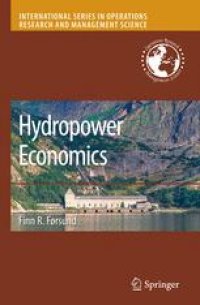
Ebook: Hydropower Economics
Author: Finn R. Førsund (auth.)
- Tags: Energy Economics, Operations Research/Decision Theory, Renewable and Green Energy, Environmental Economics, Environmental Management, Econometrics
- Series: International Series In Operations Research & Management Science 112
- Year: 2007
- Publisher: Springer US
- Language: English
- pdf
HYDROPOWER ECONOMICS examines sustainable alternate energy sources beginning with modeling hydropower and extending the model to include thermal power and wind power. The book will use various econometric measures, equilibrium metrics, OR methods, and DEA/productivity analyses to analyze and model the optimal use of these alternate energy sources. Because these problems are dynamic in nature, dynamic methods are used to model the problems. The book derives results on the allocation of the amounts of alternate sources of energy (water, thermal, and wind) required to produce electricity at acceptable levels over time. Graphic illustrations of the analytical and mathematical modeling used to reach research conclusions are used throughout the book.
In addition to the analyses, various market scenarios are discussed and how effective market systems may be in delivering electric power at acceptable and sustainable levels of supply, cost, and price. Productivity frontiers (benchmarks) are outlined in the book. These productivity frontiers or benchmarks are established from data derived from the Scandinavian experience. Optimal solutions for sustainable alternate energy systems at acceptable costs are outlined in the monograph.
HYDROPOWER ECONOMICS examines sustainable alternate energy sources beginning with modeling hydropower and extending the model to include thermal power and wind power. The book will use various econometric measures, equilibrium metrics, OR methods, and DEA/productivity analyses to analyze and model the optimal use of these alternate energy sources. Because these problems are dynamic in nature, dynamic methods are used to model the problems. The book derives results on the allocation of the amounts of alternate sources of energy (water, thermal, and wind) required to produce electricity at acceptable levels over time. Graphic illustrations of the analytical and mathematical modeling used to reach research conclusions are used throughout the book.
In addition to the analyses, various market scenarios are discussed and how effective market systems may be in delivering electric power at acceptable and sustainable levels of supply, cost, and price. Productivity frontiers (benchmarks) are outlined in the book. These productivity frontiers or benchmarks are established from data derived from the Scandinavian experience. Optimal solutions for sustainable alternate energy systems at acceptable costs are outlined in the monograph.
HYDROPOWER ECONOMICS examines sustainable alternate energy sources beginning with modeling hydropower and extending the model to include thermal power and wind power. The book will use various econometric measures, equilibrium metrics, OR methods, and DEA/productivity analyses to analyze and model the optimal use of these alternate energy sources. Because these problems are dynamic in nature, dynamic methods are used to model the problems. The book derives results on the allocation of the amounts of alternate sources of energy (water, thermal, and wind) required to produce electricity at acceptable levels over time. Graphic illustrations of the analytical and mathematical modeling used to reach research conclusions are used throughout the book.
In addition to the analyses, various market scenarios are discussed and how effective market systems may be in delivering electric power at acceptable and sustainable levels of supply, cost, and price. Productivity frontiers (benchmarks) are outlined in the book. These productivity frontiers or benchmarks are established from data derived from the Scandinavian experience. Optimal solutions for sustainable alternate energy systems at acceptable costs are outlined in the monograph.
Content:
Front Matter....Pages i-xii
Introduction....Pages 1-18
Water as a Natural Resource....Pages 19-31
Hydropower with Constraints....Pages 33-66
Multiple Producers....Pages 67-93
Mix of Thermal and Hydropower Plants....Pages 95-120
Trade....Pages 121-149
Transmission....Pages 151-179
Market Power....Pages 181-211
Uncertainty....Pages 213-238
Summary and Conclusions....Pages 239-249
Back Matter....Pages 251-261
HYDROPOWER ECONOMICS examines sustainable alternate energy sources beginning with modeling hydropower and extending the model to include thermal power and wind power. The book will use various econometric measures, equilibrium metrics, OR methods, and DEA/productivity analyses to analyze and model the optimal use of these alternate energy sources. Because these problems are dynamic in nature, dynamic methods are used to model the problems. The book derives results on the allocation of the amounts of alternate sources of energy (water, thermal, and wind) required to produce electricity at acceptable levels over time. Graphic illustrations of the analytical and mathematical modeling used to reach research conclusions are used throughout the book.
In addition to the analyses, various market scenarios are discussed and how effective market systems may be in delivering electric power at acceptable and sustainable levels of supply, cost, and price. Productivity frontiers (benchmarks) are outlined in the book. These productivity frontiers or benchmarks are established from data derived from the Scandinavian experience. Optimal solutions for sustainable alternate energy systems at acceptable costs are outlined in the monograph.
Content:
Front Matter....Pages i-xii
Introduction....Pages 1-18
Water as a Natural Resource....Pages 19-31
Hydropower with Constraints....Pages 33-66
Multiple Producers....Pages 67-93
Mix of Thermal and Hydropower Plants....Pages 95-120
Trade....Pages 121-149
Transmission....Pages 151-179
Market Power....Pages 181-211
Uncertainty....Pages 213-238
Summary and Conclusions....Pages 239-249
Back Matter....Pages 251-261
....